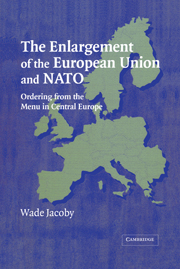Book contents
- Frontmatter
- Contents
- List of Tables, Graph, and Figures
- Preface and Acknowledgments
- Introduction: Ordering from the Menu in Central Europe
- 1 Emulation as Embedded Rationalism
- 2 Emulation as Rapid Modernization: Health Care and Consumer Protection
- 3 Emulation Under Pressure: Regional Policy and Agriculture
- 4 The Struggle for Civilian Control of the Military
- 5 Military Professionalization in War and Peace
- 6 Using Theory to Illuminate the Cases
- 7 Synthesis and Sequence: Juxtaposing Theory Traditions
- 8 Extensions and Conclusions
- Appendix: Selected List of Persons Interviewed
- Works Cited
- Index
7 - Synthesis and Sequence: Juxtaposing Theory Traditions
Published online by Cambridge University Press: 06 July 2010
- Frontmatter
- Contents
- List of Tables, Graph, and Figures
- Preface and Acknowledgments
- Introduction: Ordering from the Menu in Central Europe
- 1 Emulation as Embedded Rationalism
- 2 Emulation as Rapid Modernization: Health Care and Consumer Protection
- 3 Emulation Under Pressure: Regional Policy and Agriculture
- 4 The Struggle for Civilian Control of the Military
- 5 Military Professionalization in War and Peace
- 6 Using Theory to Illuminate the Cases
- 7 Synthesis and Sequence: Juxtaposing Theory Traditions
- 8 Extensions and Conclusions
- Appendix: Selected List of Persons Interviewed
- Works Cited
- Index
Summary
The value in juxtaposing [different] approaches is that critical confrontations reveal the junctures where a school's lacunae are best addressed by the other schools.
(Lichbach 1997: 263)All analytical approaches to politics have lacunae. Any theory that includes all relevant factors will necessarily collapse of its own weight. My pragmatic approach to synthesis differs from competitive tests or having one theory tradition subsume another. Rather, this chapter makes six broad generalizations about CEE politics by using different pairs of the three institutionalisms. The chapter also shows again that institutional theories add more by synthesis and juxtaposition than in isolation. Different combinations of tools work best on different aspects of a longer sequence.
I argued in chapter 1 that because rational choice theory conceptualizes institutions mainly as outcomes of iterated strategic behavior of self-interested actors, it is unlikely, in isolation, to be a reliable guide to the immediate postcommunist period. This is true not because there were not plenty of strategic and self-interested actors, but because these actors were working in an environment of enormous uncertainty and on the basis of prevailing institutions that, in 1989, were very far from a reflection of aggregate social preferences. For many key actors, the noise of rapid change drowned out many of the signals that might have guided interest-maximizing behavior. Two factors in particular constrained the rational calculations of CEE political elites: the dense web of legal and institutional norms that emanated from the IOs they sought to join, and historical possibilities for and constraints on policy change that lay within their own societies.
- Type
- Chapter
- Information
- The Enlargement of the European Union and NATOOrdering from the Menu in Central Europe, pp. 196 - 215Publisher: Cambridge University PressPrint publication year: 2004



